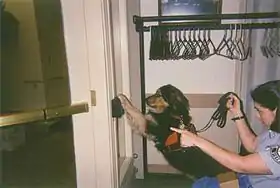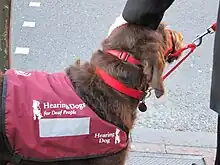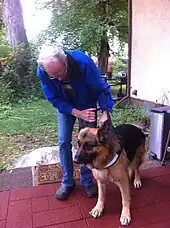

An assistance dog, known as a service dog in the United States, is a dog trained to aid or assist an individual with a disability. Many receive training from an assistance dog organization, or by from their handler, often with the help of a professional trainer.
Terminology
"Assistance dog" is the internationally established term for a dog that provides assistance to a disabled person and is task-trained to help mitigate the handler's disability. "Assistance dog" is the term adopted by organizations who train and provide assistance dogs, and some disabled people who partner with assistance dogs.[1]
Assistance or service dogs are to not be confused with Emotional Support Animals, as Emotional Support Animals are not protected under the ADA laws[2] or the Disability Act 2010 (UK) and typically have little to no training in comparison to an assistance or service dog.
Distinctive features
For a dog to be considered an assistance dog, they must meet the following criteria:
- The dog's handler must be disabled and meet the legal definition of disability in the specific country or region.
- The dog must be specifically trained to mitigate the partner's disability in some way, e.g. opening doors, detecting high blood sugar or allergens and notifying of such, alerting to a ringing phone, assisting those who are visually or mobility impaired.
- The dog must be trained to be safe with members of the public and well-behaved, as well as healthy and to not pose a hygiene threat.
Individual countries and regions will have specific laws and regulations, with these international criteria having broad recognition across the globe.[3][4]
Training process

Assistance dogs have traditionally been trained by charities and other organizations who then partner a disabled person with a trained dog when the dog has completed its training program at approximately the age of 2. Increasingly, more disabled people are self-training their own assistance dogs,[5] whereby the disabled person selects their own dog (often referred to as a 'prospect'). There is great variability between the length and type of training that any future assistance dog receives but all assistance dog candidates go through certain stages.
Selection
Assistance dog candidates are generally selected with care for appropriate health, temperament and characteristics. Large established organizations such as The Guide Dogs for the Blind select and maintain their own breeding stock to ensure healthy pups with desirable traits.[6] Some may carefully select prospect puppies from reputable breeders, or they may choose to commence training with a dog who was already part of the family. The reality TV show Rescue Dog to Super Dog featured the process of carefully selecting rescue dogs from shelters to train as assistance dogs.[7]
Socialization
The first period of a prospect's life as a puppy is normally spent in socialization rather than formal training. Large organizations often use puppy foster parents during the pups' first year so the prospect grows up in a normal family environment surrounded by the sights, sounds and smells they will later work in to make them more effective.[8][9] Owner-trainers refers to owners who raise their pups themselves.
Task training
Once a puppy is old enough they will commence their specialist training which will include training in work and/or tasks. The tasks that an assistance dog prospect will learn depend on the disabilities that their current or future handler has and there is therefore almost no limit on the types of tasks a dog can be trained to. These may vary from picking up dropped items and taking laundry out of a washing machine to interrupting self-harming behaviors to providing deep pressure therapy for an autistic person.[10] In the US, the only two questions an assistance dog handler may be asked to confirm their dog is an assistance dog is whether they have a disability and whether tasks the dog does to mitigate that disability.[11]
Obedience and public access

At the same time as learning their unique tasks to support their handler, an assistance dog candidate needs to learn how to be well behaved, polite and to present acceptably in public. Large organizations and owner-trainers who train assistance dogs use differing training processes. Many owner-trainer support groups recommend following established dog obedience schemes such as the Kennel Club Bronze, Silver and Gold obedience training programme to gain a high and dependable recognized standard of obedience and behavior followed by the Public Access Test. which evaluates a dog's ability to behave appropriately in public, and in places not normally deemed pet friendly where a person may enter with an assistance dog, such as a supermarket or restaurant.[12]
Types
In the United States, assistance dogs fall into two broad categories: service dogs and facility dogs.[13] Service dogs are defined by the Americans with Disabilities Act as dogs that are individually trained to do work or perform tasks for people with disabilities. State and local governments, businesses, and nonprofit organizations that serve the public generally must allow service animals to accompany people with disabilities in all areas of the facility where the public is normally allowed to go.[14] Facility dogs are used by working professionals to aid multiple people.[15] Therapy dogs, a subset of facility dogs, are specifically trained to provide emotional support, affection, and comfort to individuals in various settings such as hospitals, nursing homes, schools, and disaster relief areas. These dogs play a crucial role in improving mental health, reducing stress, and creating a sense of well-being among the people they interact with.[16]

Common examples of assistance dogs include:
- Guide dogs assist the blind and the visually impaired.
- Hearing dogs, or signal dogs, help the deaf and hard of hearing.
- Mental health assistance dogs
- Mobility assistance dogs
- Medical response dogs
- Psychiatric service dogs
- Autism Assistance dogs
Common examples of facility dogs include:[15]
- Courthouse facility dogs are typically handled by professionals working in the legal system. They are often used to assist crime victims, witnesses, and others during the investigation and prosecution of crimes as well as other legal proceedings.
- Facility dogs in educational settings are usually handled by special education teachers to facilitate interaction with the students.
- Facility dogs in healthcare environments are typically handled by physical therapists, psychologists, and other healthcare professionals to facilitate recovery and symptom management for patients.
Similarities and differences between facility dogs and therapy dogs
Because both may aid people in similar settings such as healthcare environments, facility dogs are often mistakenly called therapy dogs; however, there are several important distinctions between them. Facility dogs are trained by accredited assistance dog organizations and therapy dogs are trained by their owners. Facility dogs may be handled by a wide variety of working professionals, while therapy dogs must be handled by their owners.
Facility dogs are trained by canine professionals or by their owner for a period of 18 to 24 months and must pass very rigorous tests before graduating from an assistance dog organization.[17] In contrast, registration for therapy dogs by a therapy dog organization does not require enrollment in obedience classes or therapy dog classes, meaning that therapy dogs often undergo a much less rigorous training process. Furthermore, the tests that therapy dogs must pass are less complicated and challenging than those taken by facility dogs.[18]
A person with either a therapy dog or a facility dog must have permission from the facilities they visit before they can enter with their animal. They do not have the right to demand access to places where pets are not generally permitted, or to have fees associated with their pets waived.[19]
See also
- Assistance animal – Animal to assist people with disabilities
- Autism service dog – Type of service dog
- Cell dog
- Bravehound
- Courthouse facility dog – trained facility dog trained to assist crime victims, witnesses and others during the investigation and prosecution of crimes
- Dogs for Good (in the UK)
- Veterans With Dogs (in the UK)
- Hearing Dogs for Deaf People (in the UK)
- Medical response dog – Type of service dog
- Mobility assistance dog – Type of service dog
- Psychiatric service dog – Type of service dog
- Seizure dog – Assists person during or immediately before or after a seizure
- Working dog
References
- ↑ Assistance Dogs International. "A Guide to Assistance Dog Law" (PDF). Assistance Dogs International. Archived from the original (PDF) on August 11, 2013. Retrieved 25 August 2018.
- ↑ "Americans with Disabilities Act". DOL. Retrieved 2023-10-29.
- ↑ The Equality and Human Rights Commission. "Assistance Dogs. A Guide For All Businesses" (PDF). Archived from the original (PDF) on 22 August 2017. Retrieved 25 August 2018.
- ↑ "Standards". Assistance Dogs Europe. Archived from the original on 3 January 2015. Retrieved 25 August 2018.
- ↑ Yamamoto, Mariko; Hart, Lynette A. (2019-06-11). "Professionally- and Self-Trained Service Dogs: Benefits and Challenges for Partners With Disabilities". Frontiers in Veterinary Science. 6: 179. doi:10.3389/fvets.2019.00179. ISSN 2297-1769. PMC 6579932. PMID 31245394.
- ↑ Guide Dogs. "Selection and monitoring of breeding stock". Guide Dogs. Retrieved 25 August 2018.
- ↑ "Rescue Dog to Super Dog". All 4. Retrieved 25 August 2018.
- ↑ "Become a Puppy Parent". Canine Partners. Retrieved 25 August 2018.
- ↑ "Can you help us Train a Puppy". Hearing Dogs for the Deaf.
- ↑ Froling, Joan. "Assistance Dog Tasks". IAADP. Retrieved 25 August 2018.
- ↑ US Department of Justice. "Frequently Asked Questions About Service Animals and the ADA". Retrieved 25 August 2018.
- ↑ "Public Access Test". IAADP. Retrieved 25 August 2018.
- ↑ "Canine Companions for Independence". Archived from the original on 2016-11-20. Retrieved 2015-07-24.
- ↑ "ADA 2010 Revised Requirements: Service Animals". www.ada.gov. 28 March 2023.
- 1 2 "Facility Dogs - CCI". Archived from the original on 2015-07-25. Retrieved 2015-07-24.
- ↑ "What is a Therapy Dog?". MyServiceAnimal. 6 September 2022. Retrieved 18 April 2023.
- ↑ "Training Standards - Assistance Dogs International". Archived from the original on 2015-07-24. Retrieved 2015-07-24.
- ↑ "Therapy Dogs International". www.tdi-dog.org.
- ↑ "Rights - Service Dog Central". Archived from the original on 2021-04-15. Retrieved 2015-07-24.
.jpg.webp)